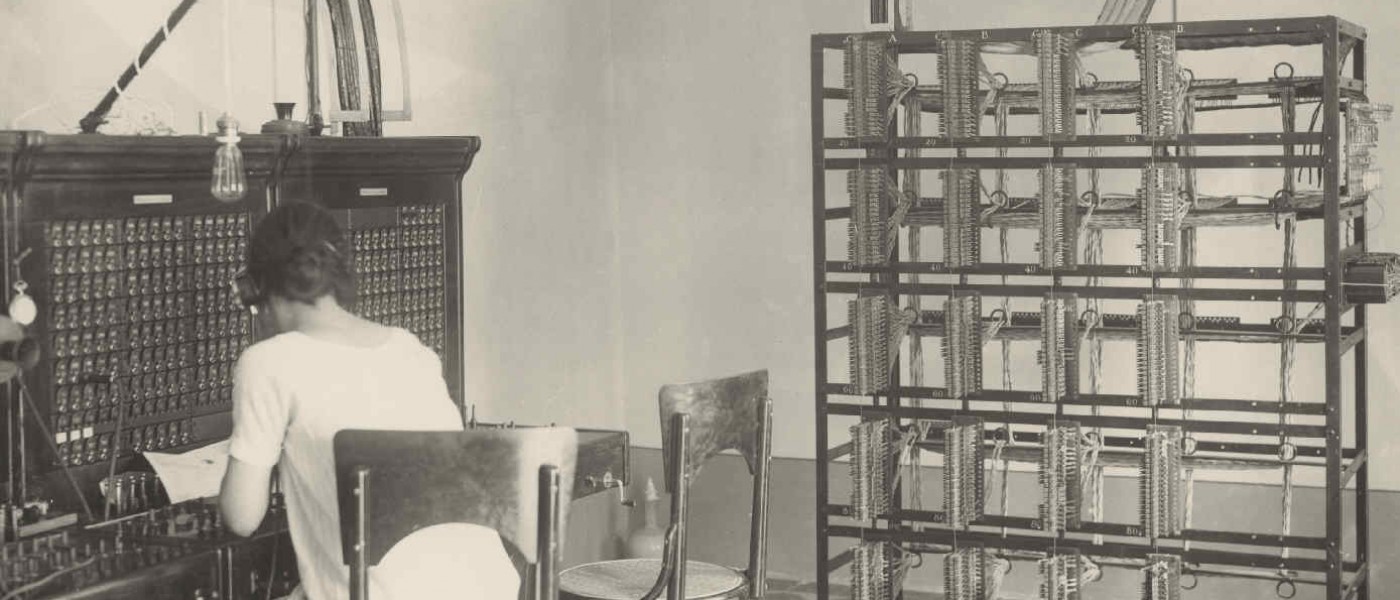
‘Telephonists: the World in their Hands’ pays homage to the key role that these women played in developing communications in Spain and, indeed, the world.
‘Telephonists: the World in their Hands’ pays homage to the key role that these women played in developing communications in Spain and, indeed, the world.
Following on from previous ephemeris, ‘Telephonists: the World in their Hands’ is the latest offering to be presented, a homage to the key role that these women played in developing communications in Spain and, indeed, the world. A series of documents, images and objects from Telefónica’s Historical Technological Heritage gives an insight into the work of these women, their everyday challenges, their difficulties, their advantages… Las telephonists, operators, or ‘young ladies’ were unquestionably the voices of an era. From 11 July on the second floor of Espacio Telefónica.
A new job: better status
In the early 20th century, working at Telefónica represented a considerable step up the social ladder. Despite being a demanding job, it enjoyed more prestige than other jobs carried out by women in workshops, factories, domestic service or the farm; working conditions were better and the salary was higher. Other factors, such as the social recognition for their job and relationships with other colleagues outside the purely family milieu offered women at the dawn of the century a new perspective of their situation, their role in society and their relationship with what was still a profoundly traditional milieu. These were the first steps towards the modern woman.
Selection process for the position
To be taken on as a telephonist, the women had to pass various tests: dictation, performing different mathematical calculations, reading a text over the phone and, most unusual of all, a check on the length of their arms! This would ensure that the woman could reach the entire span of her workstation: a bell would sound if, extending both arms, she could touch two switches at the same time at a certain distance from each other. The general culture tests, at first sight very simple, was a very valid selection test in that women’s access to basic education at that time was very limited.
What did the telephonists do?
Before calls between telephones could be established automatically, all calls were placed via a telephone switchboard. If a subscriber wanted to call someone else, they had to get in contact with their central switchboard. This is where the telephone cables ended up and where a telephone operator would ask them which number they wanted to call. Once established, she would put the two interested parties in contact with each other manually. Thus, all communication always passed through the hands of these employees, who were almost always women. In most telephone companies, this was an exclusively female position. And not just the telephonists: their supervisors and managers too. Apparently, the timbre of women’s voices was easier to understand at a time when telephone connections were not exactly clear. Apart from that, they were paid less than men, they were more skilled and disciplined, and they showed exceptional patience in their everyday dealings with users.
In Spain, telephonists dealt with telephone calls from the late 19th century. The National Telephone Company of Spain, the present-day Telefónica, started progressively installing central switchboards across the country from 1924. This equipment made it unnecessary for telephonists to supervise telephone communications but this did not entail the disappearance of telephonists. Quite the contrary: their role was fundamental in improving the country’s communications.
Lights and shadows
A telephonist’s work was extremely demanding, the time spent dealing directly with users was controlled exhaustively as they always had to treat users in a polite and friendly way. The service was tough and the shifts were hard to combine with family life. Indeed, from the 1940s, whenever a telephonist got married – as in other professions – she had to leave and devote herself to being a housewife. However, a huge sense of solidarity and team spirit built up among the telephonists, the highest of any in the Telephone Company. They spent their time with women from very different backgrounds and social classes who otherwise they would have been unlikely to encounter. They benefited from rest rooms where, while taking a break from their shift, they could relax. These rooms were equipped with magazines, books and a staff member who used to make them coffee at no charge.
The end of an era
As time went by, the profession of telephonist evolved until they eventually disappeared. The telephone service was gradually automated and inevitably the number of telephonists dropped significantly. Their work became more concentrated on interurban conference calls while the total automation of the service was being rolled out across the country. The last manual switchboard still operating in Spain was in Polopos, a village in the Alpujarra mountains of Granada. The service there was finally automated in 1988 and the work of the village telephonist became defunct. The telephonists, operators or ‘young ladies’ were unquestionably the voices of an era, the heart and soul of the company and the image of a change that nowadays could easily be forgotten. We hope this exhibition will serve as a tribute to the hard work and commitment of all those women.




